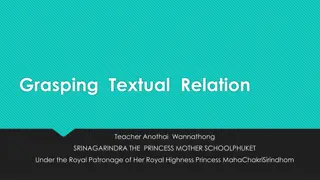Analysis of Evaluation and Conclusion Questions in Textual Analysis
Evaluation and Conclusion questions play a crucial role in assessing the effectiveness of an author in achieving specific effects and summarizing key points in a passage. These types of questions are commonly found in textual analysis tasks to evaluate the success of conveying ideas and themes. Evaluation questions focus on assessing the author's effectiveness, while Conclusion questions examine the success of summarizing main points. By analyzing specific examples from Scottish Poetry, this content provides insights into how to approach and respond to Evaluation and Conclusion questions.
Download Presentation

Please find below an Image/Link to download the presentation.
The content on the website is provided AS IS for your information and personal use only. It may not be sold, licensed, or shared on other websites without obtaining consent from the author. Download presentation by click this link. If you encounter any issues during the download, it is possible that the publisher has removed the file from their server.
E N D
Presentation Transcript
Evaluation Evaluation questions are designed so you can examine HOW EFFECTIVE the author has been in achieving a particular effect. They may appear as stand-alone questions but are ore often integrated with an analysis question. They can often be identified by the phrase how effective ? Evaluation questions include: Conclusion Passage as a whole
Conclusion Conclusion questions are asking how successful the final paragraph/sentence of a passage is in summarising or rounding up what a writer is trying to say. As you know, conclusions are summaries of what has been said/written. In order to answer a conclusion question you need to find pieces of the conclusion which link to previous ideas. In order to do this you need to have read the whole passage.
Conclusion 1. Quote the part of the conclusion that links to an earlier part of the passage 2. Explain how it links and why this is successful (what are they trying to say/reinforce/leave you thinking about?) As we need a whole passage to practice this I have taken an example from the Scottish Poetry (this type of question could come up in textual analysis too!)
Example - Duffy What gets me now is not the idiocy or greed but lack of thought for me. Pure selfishness. I sold the contents of the house and came down here. I think of him in certain lights, dawn, late afternoon, and once a bowl of apples stopped me dead. I miss most, even now, his hands, his warm hands on my skin, his touch. How successful is the final stanza of Mrs Midas as a conclusion to the poem? 2 marks
Example - MacCaig Aunt Julia spoke Gaelic very loud and very fast. By the time I had learned a little, she lay silenced in the absolute black of a sandy grave at Luskentyre. But I hear her still, welcoming me with a seagull's voice across a hundred yards of peatscrapes and lazybeds and getting angry, getting angry with so many questions unanswered. How successful is the final stanza of Aunt Julia as a conclusion to the poem? 2 marks
Example - Duffy What gets me now is not the idiocy or greed but lack of thought for me. Pure selfishness. I sold the contents of the house and came down here. I think of him in certain lights, dawn, late afternoon, and once a bowl of apples stopped me dead. I miss most, even now, his hands, his warm hands on my skin, his touch. sold the contents of the house refers back to the separation between Mrs Midas and her husband it is now complete (1) certain lights reminds us of the start of the poem, it began at dinner time, and references to times of change (1) bowl of apples is a reminder of the golden pear (1) his hands his touch indicates the loss of the close relationship described in the poem (1)
Example - MacCaig Aunt Julia spoke Gaelic/ very loud and very fast./ By the time I had learned/ a little, she lay/ silenced in the absolute black/ of a sandy grave/ at Luskentyre./ But I hear her still, welcoming me/ with a seagull's voice/ across a hundred yards/ of peatscrapes and lazybeds/ and getting angry, getting angry/ with so many questions/ unanswered. very loud and very fast is a repetition of the opening of the poem. It reminds us of his struggle to understand his aunt (1) silenced contrasts with the picture he has created of his aunt being loud and full of life (1) sandy grave at Luskentyre reminds us of his aunt s connection to nature and where she comes from (1) peatscrapes and lazybeds reminds us of the natural terrain she spent her life working on (1)
Passage as a whole - summarising The final question in a close reading may ask you to summarise something about the passage. To answer this you must have read the whole passage! These questions are often high in marks about 5 or 6 so you need a number of points/examples. The question should direct you to look at the whole passage to find your answer.
Passage as a whole - summarising Method 1. Highlight in the passage the points you would like to make 2. In bullet points, put these into your own words in your answer. 1 point = 1 mark.

























